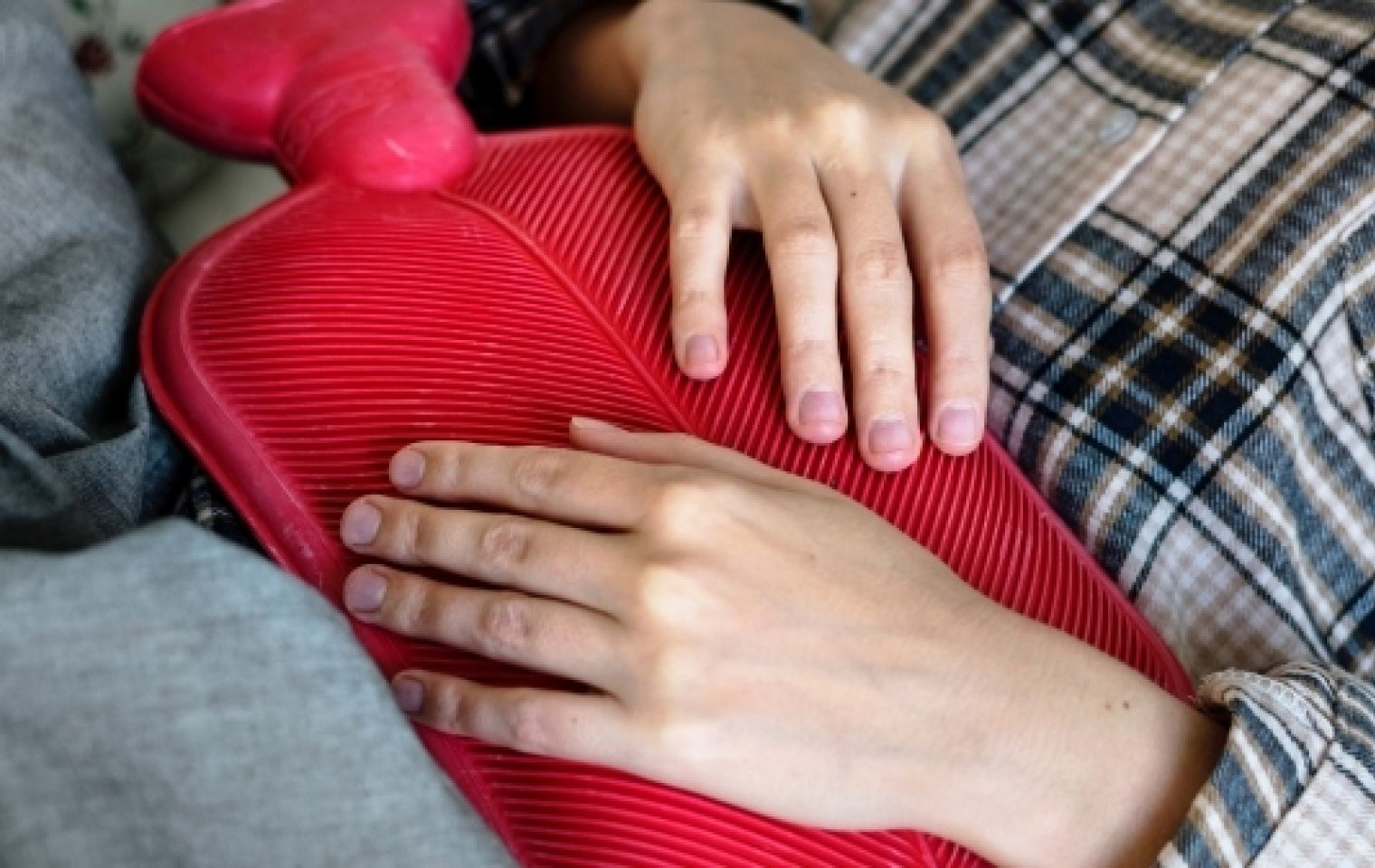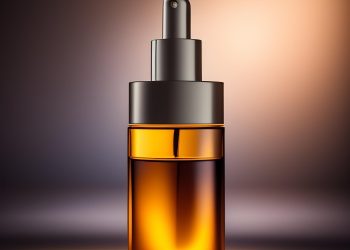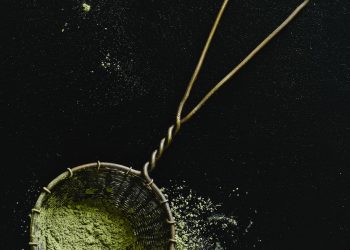Are you looking for ways to get of period cramps faster?
You are not alone in this. Cramps during a period is a very common phenomenon for women.
Also called dysmenorrhea, period cramps refer to the throbbing pain in the lower part of the abdomen before or during menstruation [1, 2].
For some women, the problem is tolerable, but for others, it can be so severe that daily activities are affected [2].
We have some simple and easy home remedies that you can adapt to get rid of extreme menstrual cramps.
Here in this article, we will cover the following topics:
- A quick guide to period cramps
- 21 home remedies to get rid of period cramps naturally
- Some frequently asked questions regarding this topic
- Tips and precautions
RELATED: 10 Essential Oils for Menopause that All Women Should Know
Period Cramps: A Quick Guide
Menstrual cramps(dysmenorrhea) experienced by women are a throbbing pain in the lower abdomen. Women have such cramps before and during their menstrual cycle.
Menstrual cramps, before or during menstrual periods is very annoying and may hamper daily activities.
There are two types of dysmenorrhea: primary and secondary [3].
Primary dysmenorrhea occurs in young women as a result of “increased activity of the hormone prostaglandin” in the uterus [3].
Secondary dysmenorrhea, meanwhile, is more common among older women who may issue with the uterus or other organs in the pelvis [3].
Causes of Period Cramps:
When the uterus contracts during the periods, hormones like prostaglandins cause the pain and inflammation triggering the uterine muscles to contract. High levels of prostaglandins are the main reason for severe pain faced by some women.
However,several reasons causes menstrual cramps such as:
- Endometriosis
- Adenomyosis
- Pelvic inflammatory disease
- Cervical stenosis
- Uterine fibroids
21 Home Remedies for Menstrual Cramps
To get relief from severe menstrual cramps, use these simple but evidence-based approaches.
1. Ginger
Ginger has always had a place in the kitchen, adding a unique flavor to soups and dishes.
Did you know that it has also been used since the ancient times to cure a wide range of health problems [4]?
One of the many ailments it can treat is dysmenorrhea [5].
The Pain Management Nursing Journal published a study in 2014 citing the effectiveness of ginger in relieving pain in 150 young women suffering from primary dysmenorrhea [5].
In the trial, the participants were requested to take either ginger capsules, zinc sulfate capsules or placebo capsules for four days before the start of the menstrual period up to the third day of bleeding [5].
The intensity of pain was reported to be much lower in the groups that took ginger and zinc sulfate capsules [5].
Contributing to ginger’s analgesic effects is its main compound called gingerol [6].
The study proved it in an animal trial wherein gingerol was administered in rats and was shown to have positive effects on acetic-induced writhing as well as formalin-induced licking [6].
What You’ll Need:
- One teaspoon of ginger
- 1 cup of water
Recommended Directions:
- Boil water in a pot.
- While waiting, grate ginger.
- Steep ginger in hot water for 15 minutes.
- Strain the tea.
- Drink it twice a day for one week during your menstrual period.
RELATED: 20 Great Ways Of Using Ginger To Fight Your Acne
2. Chamomile
A cup of chamomile tea has been proven helpful in alleviating pain from period cramps [7].
Chamomile’s analgesic and antinociceptive properties have been well established in scientific research [8, 9, 10].
In fact, it was found to be more superior to mefenamic acid in relieving premenstrual pain and emotional symptoms [11].
This was the result of an experiment that involved 90 female students suffering from period cramps [11].
These students were treated with either 100 mg of chamomile capsule or 250 mg of mefenamic acid three times daily during their menstrual period [11].
Pain, irritability, and stress were significantly lower among the chamomile users than the mefenamic acid takers [11].
Since chamomile is a natural remedy, you can expect that it has fewer side effects than the standard medication for pain.
What You’ll Need:
- One tablespoon of chamomile
- 1 cup of water
Recommended Directions:
- Boil water in a pot.
- Add chamomile.
- Remove from heat.
- Strain the tea.
- Drink the concoction twice a day for four to five days.
RELATED: 14 Health Benefits of Chamomile Tea (Backed by Science)
3. Lavender Oil
Famous for its therapeutic purposes, lavender proved its worth in inducing relaxation, relieving pain and treating burns or inflammation [12].
According to research done by some Iranian researchers, 96 female students who complain of cramps during their periods were made to inhale either lavender oil or placebo [13].
The research showed the students who inhaled lavender oil felt less pain when compared to the students who didn’t inhale lavender oil. Moreover, the symptoms were fewer as well than other essential oils. [13].
The use of lavender oil relieves period cramps along with decreasing the amount of bleeding [13].
Experts suggest using lavender oil for dysmenorrhea not only because it is inexpensive and easy to use but also because it has no side effects [13].
Another study featured in the Iranian Journal of Nursing and Midwifery Research has similar findings, but this one focused on aromatherapy massage [14].
A total of 80 female students were randomly divided to receive two kinds of massage therapy [14].
The first group received a massage with lavender oil and the other massage with placebo oil [14].
The experiment concluded that aromatherapy massage was more effective than the placebo oil in alleviating primary symptoms of dysmenorrhea [14].
What You’ll Need:
- Five drops of lavender oil
- One teaspoon of almond oil
Recommended Directions:
- Combine the two oils.
- Put a small amount in the abdominal area.
- Gently massage.
- Inhale remaining oil.
- Repeat remedy twice a day for one week to get rid of menstrual cramps fast.
RELATED: 11 Health Benefits of Lavender Oil That You Should Know
4. Basil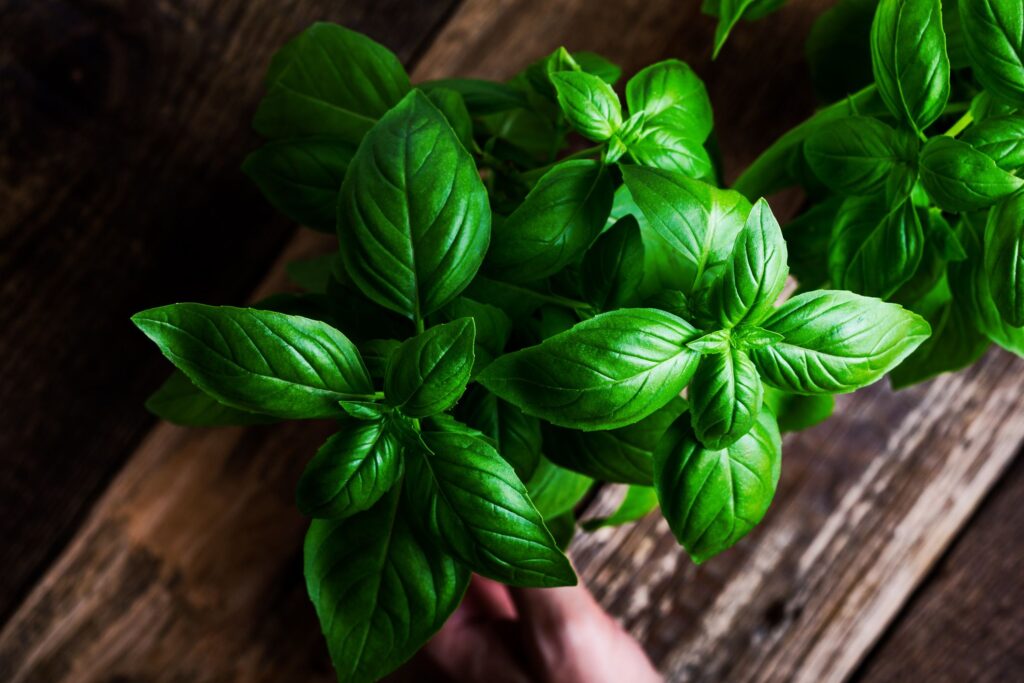
There are many uses for basil—as a culinary herb, flavoring agent, ornamental garnish, and of course, as an herbal remedy [15].
Its medicinal value is due to its high concentration of phenolic compounds [15].
These active compounds can help treat and prevent a wide array of health problems.
Traditionally, basil has been used to treat headaches, inflammation, common cold, poisoning, malaria, stomach problems and heart disease [16].
With its antinociceptive mechanisms, basil can also be used to relieve the pain and discomfort brought about by menstrual cramps [17].
A study performed in a 2011 study by Brazilian researchers showed that basil could block the signals of pain in the brain [17].
Basil appears to inhibit the biosynthesis of mediators of pain, which include prostacyclins and prostaglandins [17].
Simply put, even if you’re in pain, you’re not going to feel it because the herb’s active compounds will prevent the transmission of messages of pain to your brain.
What You’ll Need:
- One tablespoon of basil leaves
- 1 cup of hot water
Recommended Directions:
- Crush basil leaves.
- Add to hot water.
- Cover and steep for 15 to 30 minutes.
- Drink the solution three times a day to relieve pain.
5. Fennel
For many years, fennel has been used to promote menstrual flow, increase sexual drive, aid in childbirth, and boost milk supply for nursing mothers [18].
Those who are suffering from menstrual cramps can also find relief using this remedy.
Many clinical experiments confirmed that fennel works in decreasing pain caused by dysmenorrhea [19, 20, 21, 22, 23, 24].
In one of these studies, a group of scientists from Iran evaluated the effects of fennel and mefenamic acid on high school girls with menstrual pain [20].
Half of them received fennel extract while the other half was treated with mefenamic acid [20].
Fennel’s efficacy was slightly higher than that of mefenamic acid, with 80 percent of the fennel users reporting great relief while only 73 percent of the mefenamic users showed pain decrease [20].
In another study, 50 young girls with dysmenorrhea were instructed to take either 30 mg of fennel capsule or a placebo four times a day for three days [22].
There was a significant difference noted between the two groups, with those taking fennel capsules experiencing a much higher pain relief than those who consumed the placebo [22].
Experts explain that fennel works by reducing contractions in the uterus [24].
What You’ll Need:
- One teaspoon of fennel seeds
- 1 cup of water
- One teaspoon of honey
Recommended Directions:
- Boil water in a pot.
- Transfer hot water to a cup.
- Add fennel seeds to the cup of water.
- Steep for 30 minutes.
- Strain the seeds.
- Add honey.
- Drink the tea twice a day for three to four days.
RELATED: 14 Benefits of Fennel Tea You Don’t Want to Miss Out on
6. Cinnamon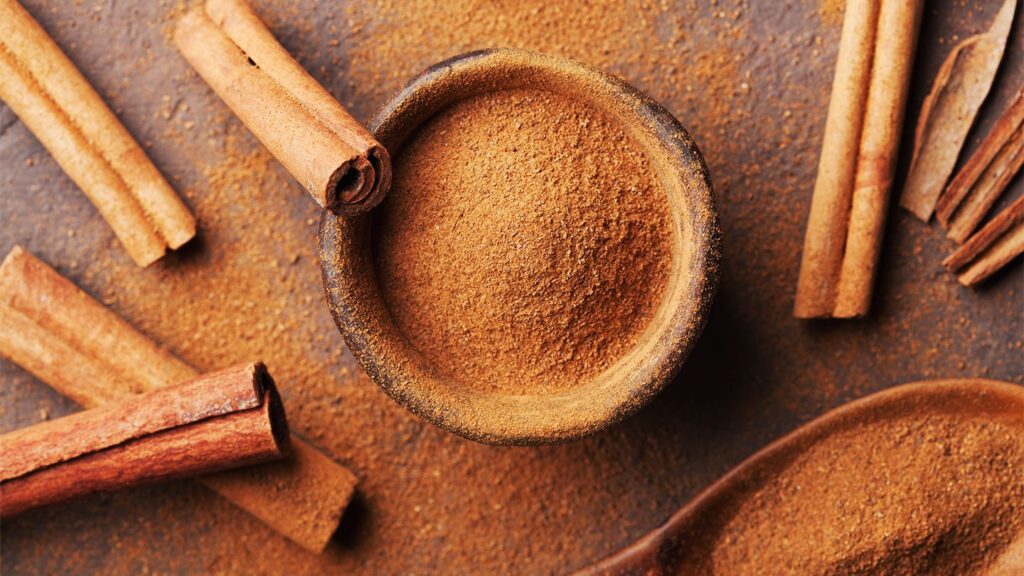
Cinnamon is more than just a sweetener that makes desserts more palatable.
It can also be used to treat many illnesses, including dysmenorrhea.
According to a study conducted by Korean researchers in 2012, cinnamon is one of the essential oils used for aromatherapy massage that caused a significant reduction in menstrual pain [25].
Female high school students with period cramps were randomized to receive either acetaminophen or an aromatherapy massage using a blend of cinnamon, ginger, marjoram, geranium and clary sage [25].
Surprisingly, reduction of pain was more noticeable in the aromatherapy massage group than in the other group [25].
Clinical data reveals that it works better than acetaminophen in providing pain relief in dysmenorrhea [25].
Since it remains unclear whether it’s the massage or the aromatherapy oils that caused the beneficial effects, a more thorough and specific study should be done to verify the findings [25].
What You’ll Need:
- 1/2 teaspoon of cinnamon powder
- One tablespoon of honey
- One glass of hot water
- Three drops of cinnamon oil
- Two drops of geranium oil
- Two drops of clary sage oil
Recommended Directions:
- Mix cinnamon powder and honey to water.
- Drink three times a day during your period.
- Combine the essential oils in a glass jar with lid.
- Shake to blend.
- Apply a thin layer of oil blend to your abdominal area.
- Massage gently for 15 minutes.
- Repeat remedy twice a day for one week or until menstruation lasts.
RELATED: The Benefits of Honey and Cinnamon for Weight Loss
7. Rosemary Oil
During the ancient times, rosemary was placed in babies’ cradles to protect them from harm [26].
While there’s no scientific proof to this particular folkloric use of rosemary, this herb has been proven beneficial in many other health-related issues including colic, respiratory ailments, and dysmenorrhea [26].
Rosemary works by preventing pain signals from being transmitted to the brain.
Its antinociceptive actions have been verified in several studies [27, 28].
These studies made use of animal subjects induced with pain to show how effective rosemary is a pain reliever.
Both show remarkable results, but further trials on humans, preferably on female subjects with dysmenorrhea are necessary to validate the results [27, 28].
What You’ll Need:
- Five drops of rosemary oil
- One teaspoon of olive oil
Recommended Directions:
- Combine rosemary and olive oils.
- Spread a thin layer of oil mixture on the abdomen.
- Gently massage painful area.
- Do this once or twice a day for three to four days.
RELATED: 13 Health Benefits and Uses of Rosemary Oil (Backed by Evidence)
8. St. John’s Wort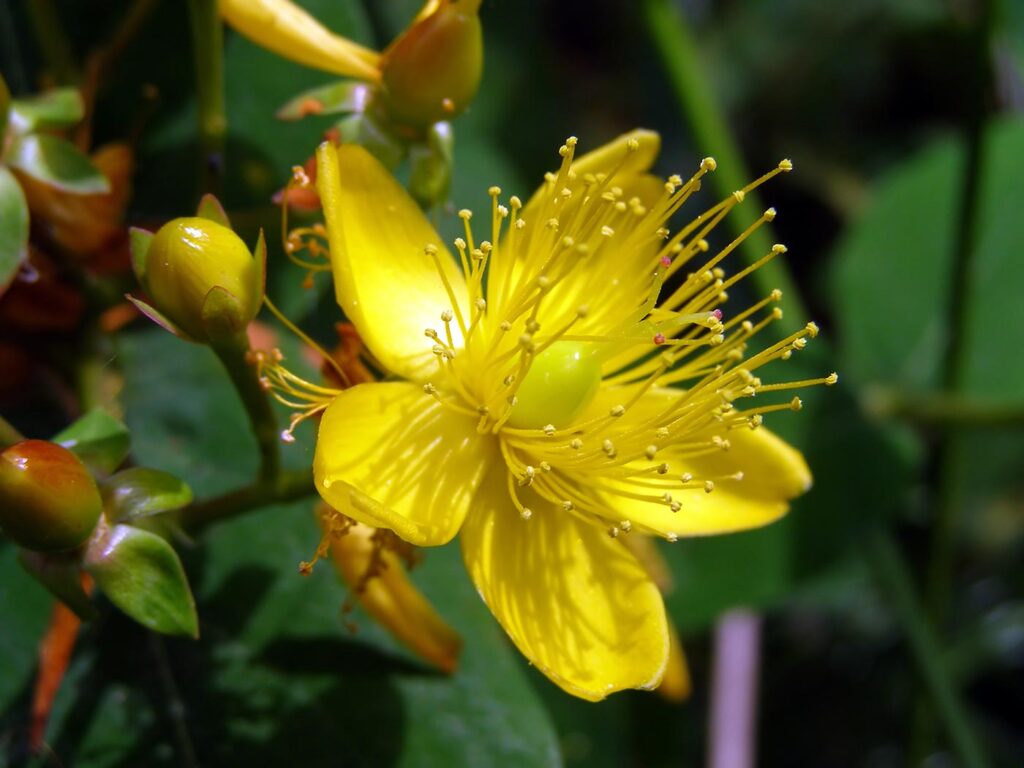
St. John’s Wort is said to be one of the oldest and most widely researched herbal remedy [29].
In Germany, it is licensed as a treatment for depression, anxiety and sleeping disorders [30].
However, these are not all that this herb can do, it can also treat many other kinds of illnesses, including the pain caused by dysmenorrhea.
In a study performed in the University of Exeter in the United Kingdom, it was found that women who used St. John’s Wort experienced great improvement in symptoms of premenstrual syndrome (PMS) [31].
St. John’s wort was administered to some of the 19 female participants who have been diagnosed with PMS [31].
A success rate of 50 percent was recorded in the study [31].
It was also noted that the herb was well-tolerated by the users and that there were no adverse reactions afterward [31].
Another study also done in the UK released similar findings, indicating that daily intake of this herb worked more effectively than the placebo in alleviating not only physical but also behavioral symptoms that occur before the menstrual period [32].
Examples of behavioral symptoms are depression, anxiety, impulsivity, and aggression [32].
What You’ll Need:
- Two teaspoons of dried St. John’s Wort
- 1 cup of water
Recommended Directions:
- In a pot, bring water to a boil.
- Add St. John’s wort.
- Stir well.
- Remove from the heat.
- Strain the tea.
- Drink the solution every night before sleeping.
RELATED: 12 Essential Oils For Better Sleep Everyday (I Like No#2 Most)
9. Parsley
Most people look at parsley and see nothing but a handful of leafy greens to garnish their meals.
What many do not know is that it has beneficial effects on the body.
Parsley is an efficient antiseptic, anti-inflammatory, a carminative and gastroprotective agent that can treat urinary disease, gastrointestinal problems, and dysmenorrhea [33].
An experimental study also shows that parsley leaves have strong analgesic and antinociceptive properties that can give relief to those complaining of period cramps [34].
Using parsley is a quick and inexpensive way to get rid of pain during menstruation.
Like most of the remedies listed here, this one also doesn’t have any unpleasant side effects to worry about.
What You’ll Need:
- 1/4 cup of fresh parsley
- 1 cup of hot water
Recommended Directions:
- Add parsley to hot water.
- Wait for 15 minutes for the tea to steep.
- Strain the tea and drink it twice a day until pain is relieved.
10. Flaxseed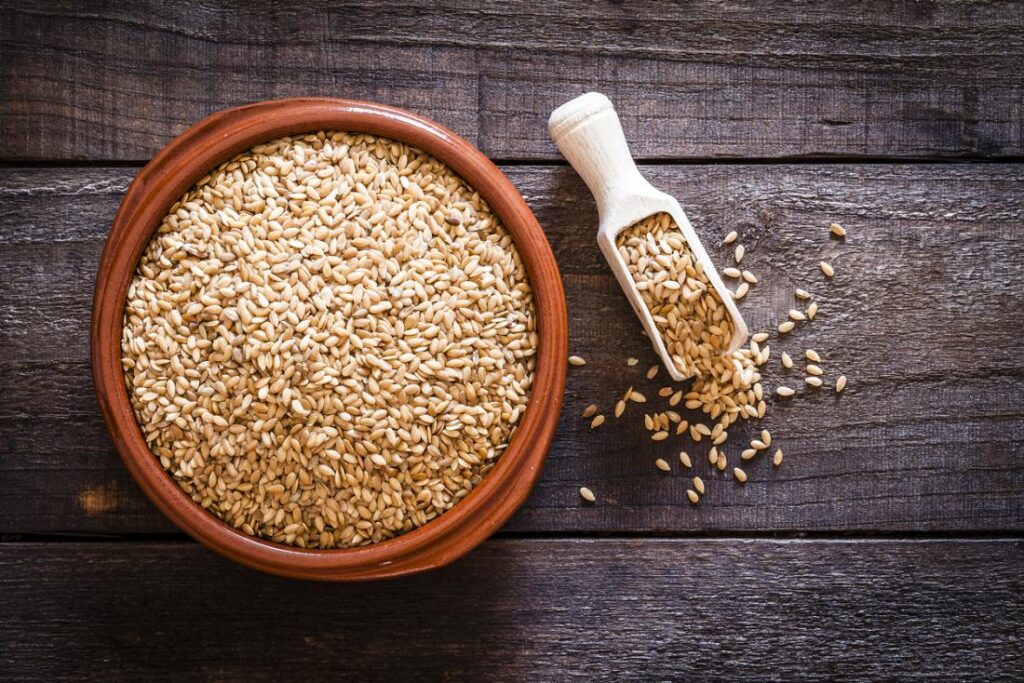
Chewing on flaxseeds can be beneficial for those who can no longer tolerate menstrual pain.
For many years, scientists have been greatly interested in the biological activities of flaxseeds, which are attributable to their high amount of phenolic compounds [35].
Apart from being a good source of antioxidants, flaxseeds are also rich in omega three fatty acids, which according to one study, can help relieve discomfort caused by painful menstruation [36].
In a 2016 study, it was reported that flaxseeds could also tone down the amount of bleeding during menstruation [37].
Excessive bleeding during menstruation not only leads to more pain but also to greater discomfort and even anemia [37].
This is why it helps to control bleeding with the use of flaxseeds [37].
Results show that intake of 25 grams of flaxseed daily for two menstrual cycles was enough to minimize menstrual bleeding [37].
What You’ll Need:
- One tablespoon of flaxseeds
Recommended Directions:
- Chew flaxseeds each time pain is felt.
- Do this for four to five days or until the menstrual period is over.
11. Exercise
Exercise can help alleviate menstrual pain and also uplift the mood of women going through their menstruation.
There is scientific evidence to prove this claim.
In 2006, 150 high school female students who suffered from serious cramps during their periods were divided into two groups: exercise and non-exercise [38].
It was observed that the intensity of pain was greatly reduced in the group of girls who did the recommended exercise program [38].
Researchers who did this study also noted that the use of sedative tablets made this particular remedy even more effective [38].
What You’ll Need:
- 30 minutes a day
Recommended Directions:
- Engage in aerobic exercises 30 minutes a day during your menstrual period.
- Do not engage in exercises that are too strenuous as this may aggravate your symptoms.
RELATED: Drinking Oolong Tea for Weight Loss: Good or Bad?
12. Warm Compress
For years, people have been using a warm compress to treat all sorts of pain.
So it shouldn’t come as a surprise that this remedy also works for pain and discomfort during the menstrual period.
A 2012 study confirms the efficacy of heat therapy as a treatment for period cramps [39].
In this experiment, 15 female students were treated with either a warm compress or effleurage technique [39].
Effleurage is a massage technique using gentle massage strokes, typically performed before deep tissue massage [40].
Research reveals that both methods were highly effective in reducing the severity of menstrual pain [39].
What You’ll Need:
- 1 cup of water
Recommended Directions:
- Boil water in a pot.
- Remove from heat.
- Transfer hot water to a bowl.
- Soak a towel in the water.
- Wring out
- Chew flaxseeds each time pain is felt.
- Do this for four to five days or until the menstrual period is over.
13. Magnesium Intake
Magnesium is said to be helpful in easing period cramps. [41]
It is a versatile mineral which promotes good muscle tone and improves healthy nerve function, resulting in fewer cramps during periods
According to the UMMC, the amount of magnesium intake for women in their periods should be 360 mg daily for three days, while Dr. Sims claims that the dose depends on the severity of cramps as well. [42]
Therefore, it’s recommended not to go overboard with this idea. Just a normal addition of some healthy foods that are rich in magnesium in your diet will do.
What You’ll Need:
- A handful of almond nuts
- A cup of boiled spinach or other green leafy vegetables
- A cup of brown rice
Recommended Directions:
- You can include eating brown rice with boiled spinach or other leafy vegetables in your diet when you are in periods.
- During the day, you can grab a handful of almond or mixed nuts and eat them.
14. Blackstrap Molasses
Blackstrap Molasses is the byproduct of raw sugar cane after the maximum extraction of sugar or sucrose out of it.
The thick black syrup is full of vital minerals and vitamins. It is rich in potassium, iron, calcium, magnesium, vitamin B6, etc.
Blackstrap molasses is one of the effective home remedies for menstrual cramps. The nutrient-filled syrup helps to lower blood clots and eases the muscles of the uterus walls.
Thus, blackstrap molasses helps to get rid of menstrual cramps naturally.
What You’ll Need:
- Two teaspoons of blackstrap molasses
- 1 cup of warm milk
Recommended Directions:
- Mix blackstrap molasses with milk and stir well.
- Consume the delicious drink during your menstrual time to relieve the cramps.
RELATED: Top 10 Benefits of Vitamin B6 That You Should Know
15. Papaya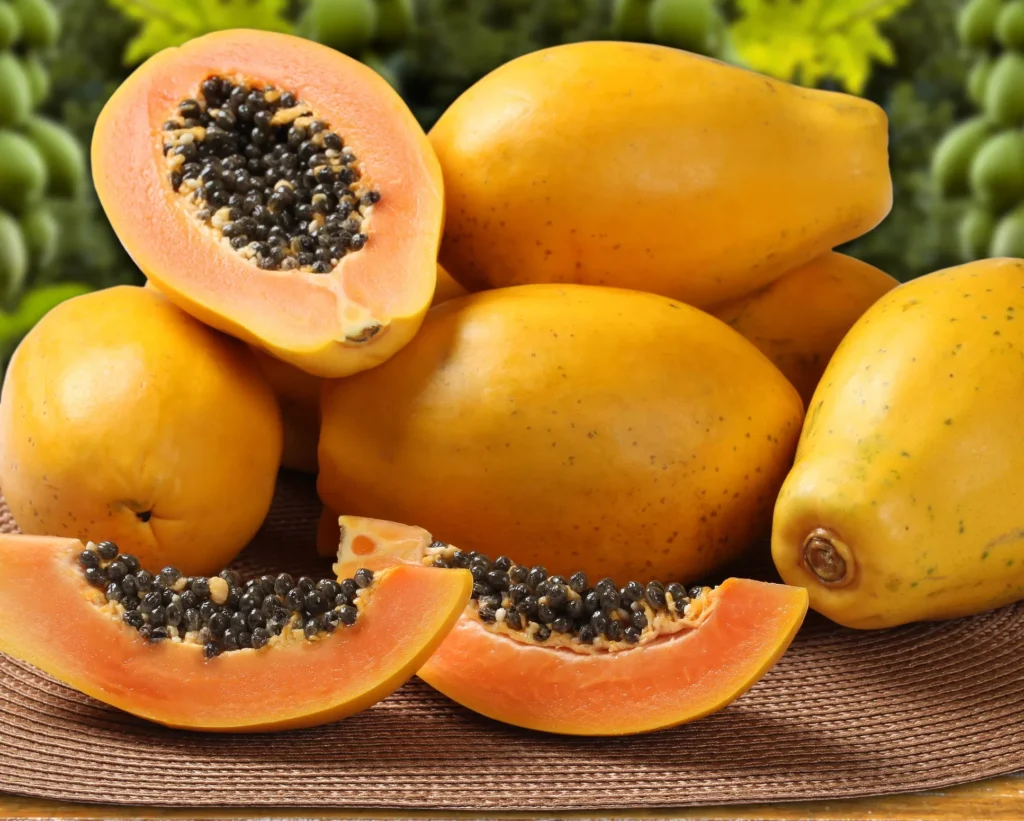
Papaya is a delicious fruit with a long list of health benefits. The nutrient-rich fruit contains essential minerals such as iron, carotene, calcium, potassium, vitamin A, C, and other components.
These vital nutrients make papaya a potent anti-inflammatory agent to manage menstrual cramps. Papaya contributes to easing muscle contractions and the associated period cramps.
What You’ll Need:
- Ripe or raw papaya
Recommended Directions:
- Add ripe papaya to your diet. Moreover, you can cook raw papaya and make curries.
- The treatment will help you get rid of menstrual cramps immediately.
RELATED: 18 Surprising Benefits of vitamin C
16. Improved Diet
An improved diet can help in alleviating period cramps. [42]
Maintaining a healthy diet is mandatory for healthier living.
So if you want to decrease the pain from periods, you should first grow a healthy eating habit.
To alter your diet, you can lessen the number of saturated fats and replace the void with more unsaturated fats.
Increasing the number of vegetables and decreasing unnecessary fats in your diet is the best way to do this.
What You’ll Need:
- Cutting out excess saturated fats
- Adding in unsaturated fats
Recommended Directions:
- Alter your diet and start eating according to it.
- Eat more vegetables and avoid the consumption of too much animal fats.
- Don’t go too hard on yourself rather make it a habit gradually.
17. Drink More Water
Hydration is the key to a healthy life. Consuming enough water can be the simplest natural remedy for period cramps.
Proper hydration helps to improve blood circulation, prevents bloating, water retention, and relaxes the body muscles. [43]
You may experience diarrhea along with menstrual cramps. Thus, drinking enough water can substitute for the fluid lost from your body. [43]
What You’ll Need:
- 2 liters or 8 glasses of drinking water
- Lemon and mint
- Herbal teas
- Fruits with high water content
Recommended Directions:
- Drink 2 liters or 8 glasses of water during your period days.
- You can flavor your drinking water with a dash of lemon and mint.
- Sip on herbal teas. These are excellent sources of fluid as well as medicinal components for menstrual cramps.
- Chamomile, ginger, rooibos, etc. are some of the herbal teas with anti-inflammatory properties to relieve period cramps.
- You can add fresh watery or juicy fruits to your diet. Some of the fruits with high water content include; cucumber, watermelon, celery, berries, and so forth.
18. Acupuncture and Acupressure
Acupuncture and acupressure are two eastern methods of treatment. The goal of these treatment methods is to stimulate the acupoints or trigger points in the body. Thus, you can achieve the positive effects of healing different medical conditions.
These two therapies differ from each other in the matters of executing them. In acupuncture, you need to use hair-thin needles to trigger the acupoints in the body. In the case of acupressure, you need to induce firm pressure on or give massage to the acupoints. [44]
For centuries people are using acupuncture and acupressure as natural remedies for various medical conditions. The good news is that these two holistic therapies can help you relieve menstrual cramps as well.
Acupuncture and acupressure have anti-inflammatory effects on your body. Moreover, these natural medical practices relax your nervous system, boost blood circulation and are 100% risk –free. [45]
What You’ll Need:
- Acupuncture or acupressure practitioner
- Acupuncture and acupressure manuals
Recommended Directions:
- Get hold of acupuncture or acupressure practitioner.
- You can learn about the acupoints and their exact locations from the practitioner.
- Apply pressure or insert acupuncture needles on the key points of your abdomen, back, feet, between the thumb and index fingers, etc. to relieve period cramps.
- You can have the acupressure manuals with pictures to learn the techniques.
RELATED: 10 Benefits of Acupuncture- Sometimes a little pain can be good
19. Sleep and Rest Well
Sound sleep and rest, whenever needed, is of primary importance to relieve period cramps.
Shakespeare said sleep is nature’s soft nurse.
Nothing can be more nourishing to your overall health than a sound sleep or rest. Sleep and enough rest are even more important when you are having periods and experiencing cramps. [46]
The study has confirmed that irregular sleep, insomnia, and hectic lifestyle make you fatigued and worsens menstrual cramps. Sleep and good rest can calm your nervous system, de-stress and help you lower menstrual disorders and symptoms.
What You’ll Need:
- Routine sleep pattern
- Siesta, and enough rest
Recommended Directions:
- Form and abide by a good nightly routine.
- Go to bed early at night.
- You can establish some signals to trigger sleep at the routine time.
- Some of the triggers may be soothing music, a cup of herbal tea, essential oil bath, etc.
- Avoid fiddling with smartphones or long hours before TV, social media, etc. at night.
- You can steal a couple of hours from daily activities for afternoon siesta or nap.
RELATED: 12 Essential Oils for Stress Reduction & How to Use Them
20. Apple Cider Vinegar
Apple cider vinegar has been used for a long time for the over all well-being of a person, besides being used for dressing salads, pickles, killing weeds, and many more.
Recently, researchers have found another amazing benefit of apple cider vinegar in treating menstrual cramps.
Apple cider vinegar contains calcium and potassium content in it that helps to not only decrease cramping of the uterus muscles but also helps in blood clotting to prevent the duration or blood loss, at the same time preventing anemia.
Hence, by having apple cider vinegar during the period will make your period shorter and easier to handle.
What You’ll Need:
- Two to three teaspoons of apple cider vinegar
- A cup of water
Recommended Directions:
- Dilute two teaspoons of apple cider vinegar into cool water and drink it
- Drink this solution once a day before and during your period to prevent menstrual cramps
RELATED: How to Use Apple Cider Vinegar for Acne Treatment
21. Orgasm
It may sound weird, but some researchers have backed the idea of relieving pain, stress, and frustrations with the help of a good orgasm.
During orgasm your blood flow increases, the body releases the feel-good hormones such as endorphins, etc.
Thus, after a period of euphoric pleasure through masturbation, you experience the relaxation of mind and body in the climax. Orgasm followed by good sex or masturbation helps to induce good sleep without any cramps or pain.
Tips and Precautions to Get Rid of Period Cramps
- Maintain good hygiene especially during the days of your period.
- Use lukewarm water while taking a bath during these days.
- Maintain a healthy diet.
- Drink lots of water.
- Avoid taking painkillers.
- If your pain gets severe or you face any other health issues along with the cramps, it is highly recommended to consult a doctor and ensure the necessary measures.
Some Q&A About Period Cramps
What are the common causes of irregular periods?
The common causes of irregular periods include eating disorders, stress, excessive weight gain or weight loss.
What cause prolonged periods?
Benign tumors like polyp or fibroid can be the reason behind heavy bleeding or prolonged periods.
Can antibiotics affect periods?
In most cases, they don’t, but a heavy course of antibiotics might delay period for some women.
What is period cramps formally called?
Periods of intense pain is called dysmenorrhea.
Is period cramp common?
Honestly, it is, and it is not at the same time. Period cramps are the most common problems that women face when having a period. Usually, the pain lasts for the first one or two days when the period begins. However, if this prolongs, then there may problems that you should worry about.
What is primary dysmenorrhea?
Primary dysmenorrhea is when the pain occurs due to the release of natural chemicals in the body. These are called prostaglandins. These chemicals line the uterine walls. Pain due to primary dysmenorrhea starts right before the start of menstruation each month.
What is secondary dysmenorrhea?
Secondary dysmenorrhea occurs when there is any disorder in the reproductive system. Usually, it may begin at a later stage in your life. Plus, the pain associated with secondary dysmenorrhea tends to get worse over time.
What is the cause of secondary dysmenorrhea?
Secondary dysmenorrhea can occur due to some conditions. These are:
- Endometriosis
- Adenomyosis
- Fibroids
What to do if I have secondary dysmenorrhea?
To be honest, if your condition is really bad, then you should go and get yourself checked by a gynecologist. Whatever the doctor suggests will be best for you for sure.
What are the best possible treatment for period cramps?
Usually, complicated conditions like dysmenorrhea are treated with medicine or often surgery. However, if they are less complicated, then you try using the above home remedies for best results for period cramps.
Can exercise help reduce period cramps?
Yes, it definitely can. Exercising helps to increase the level of beta-endorphins, body’s natural painkillers, that helps to reduce painful menstrual cramps. So if you want to avoid menstrual cramps in the first place, try exercising every day!
Does having chocolates help you get rid of period cramps?
Surprisingly, yes! Chocolates contain magnesium that helps to alleviate cramps. It also increases your metabolism, and since it contains endorphins (happy hormones), it will improve your mood as well.
However, you should have dark chocolates instead of milk or white chocolates like dark chocolates contain a high amount of antioxidants which is very good for the body.
What are the herbs that help get rid of period cramps?
Chinese herbs are fennel is good for getting rid of period cramps.
Does a bath help to get rid of period cramps?
Yes, having a hot bath especially on the first day of your period can relieve muscle tension, can help you get relief from anxiety and stress as well.
What kind of pills help to get rid of period cramps faster?
For mild menstrual cramps, you can take aspirin, acetaminophen, ibuprofen, or naproxen. Although there are many pills available in the market that helps to get rid of period cramps quicker, it’s always best to go for natural home remedies like placing a heating pad on your tummy or lower back.
Bottom Line
You can effectively get rid of menstrual cramps. Doctors will always suggest anti-inflammatory drugs to you if you have period cramps. These medications are said to be very effective.
However, you should not let period cramps get in the way of your daily activities.
You can easily feel better with the help of these home remedies.
These are simple to put together and are highly effective.
We hope this article was helpful to you.
If you have anything to ask regarding this, feel free to do so.
Also, don’t forget to leave a comment in our comment section below.
READ MORE: 10 Essential Oils for Menopause that All Women Should Know
